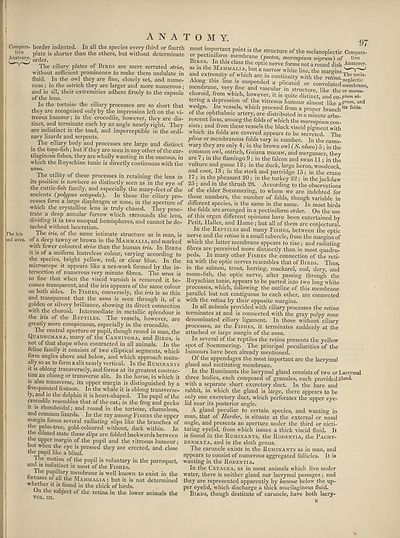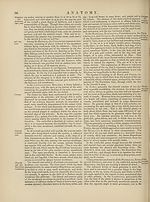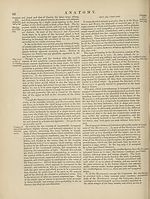Encyclopaedia Britannica > Volume 3, Anatomy-Astronomy
(105) Page 97
Download files
Complete book:
Individual page:
Thumbnail gallery: Grid view | List view

ANATOMY.
Compara¬
tive
Anatomy,
The iris
uid uvea.
border indented. In all the species every third or fourth
plate is shorter than the others, but without determinate
order.
The ciliary plates of Birds are mere serrated stria,
without sufficient prominence to make them undulate in
fluid. In the owl they are fine, closely set, and nume¬
rous ; in the ostrich they are larger and more numerous;
and in all, their extremities adhere firmly to the capsule
of the lens.
In the tortoise the ciliary processes are so short that
they are recognised only by the impression left on the vi¬
treous humour; in the crocodile, however, they are dis¬
tinct, and terminate each by an angle nearly right. They
are indistinct in the toad, and imperceptible in the ordi¬
nary lizards and serpents.
The ciliary body and processes are large and distinct
in the tope-fish; but if they are seen in any other of the car¬
tilaginous fishes, they are wholly wanting in the osseous, in
which the Ruyschian tunic is directly continuous with the
uvea.
The utility of these processes in retaining the lens in
its position is nowhere so distinctly seen as in the eye of
the cuttle-fish family, and especially the many-feet of the
ancients (polypus octopoda'). In these the ciliary pro¬
cesses form a large diaphragm or zone, in the aperture of
which the crystalline lens is truly chased. They pene¬
trate a deep annular furrow which sorrounds the lens,
dividing it in two unequal hemispheres, and cannot be de¬
tached without laceration.
The iris, of the same intimate structure as in man, is
of a deep tawny or brown in the Mammalia, and marked
with fewer coloured stria than the human iris. In Birds
it is of a uniform lustreless colour, varying according to
the species, bright yellow, red, or clear blue. In the
microscope it appears like a net-work formed by the in¬
tersection of numerous very minute fibres. The uvea is
so fine that when the viscid varnish is removed it be¬
comes transparent, and the iris appears of the same colour
on both sides. In Fishes, conversely, the iris is so thin
and transparent that the uvea is seen through it, of a
golden or silvery brilliance, showing its direct connection
with the choroid. Intermediate in metallic splendour is
the iris of the Reptiles. The vessels, however, are
greatly more conspicuous, especially in the crocodile.
The central aperture or pupil, though round in man, the
Quadrumana, many of the Carnivora, and Birds, is
not of that shape when contracted in all animals. In the
feline family it consists of two elliptical segments, which
form angles above and below, and which approach mutu¬
ally so as to form a slit nearly vertical. In the Ruminants
it is oblong transversely, and forms at its greatest contrac¬
tion an oblong or transverse slit. In the horse, in which it
is also transverse, its upper margin is distinguished by a
five-pointed festoon. In the whale it is oblong transverse¬
ly, and in the dolphin it is heart-shaped. The pupil of the
crocodile resembles that of the cat; in the frog and gecko
it is rhomboidal; and round in the tortoise, chameleon,
and common lizards. In the ray among Fishes the upper
margin forms several radiating slips like the branches of
i G P^m'tree> gold-coloured without, dark within. In
t e dilated state these slips are folded backwards between
t le upper margin of the pupil and the vitreous humour;
but when the eye is pressed they are erected, and close
the pupil like a blind.
The motion of the pupil is voluntary in the parroquet,
an^p.ls lnd1stinct in most of the Fishes.
ie pupillary membrane is well known to exist in the
foetuses of all the Mammalia ; but it is not determined
whether it is found in the chick of birds.
On the subject of the retina in the lower animals the
VOL. m.
97
ost important point is the structure of the melanoplectic Compara-
or pectimfoim membrane (pecten, marsupium nigrum) of tive
• Dfi' t\t lhlS C aSS tl?e °Ptic nerve forms not a round disk Anatomy,
as in the Mammalia, but a narrow white line, the margins
and extremity of which are in continuity with the retina The™hl-
Along this line is suspended a plicated or convoluted membrane
“T ^ fi"e ,and vascular ^ structure, like the or™!"-’
choroid, from which, however, it is quite distinct, and en-P™m ni-
tering a depression of the vitreous humour almost like a^rumi and
wedge. Its vessels, which proceed from a proper branchits
of the ophthalmic artery, are distributed in a minute arbo
rescent form, among the folds of which the marsupium con¬
sists; and from these vessels the black viscid pigment with
which its folds are covered appears to be secreted. The
plica or membranous folds vary in number. In the" casso¬
wary they are only 4; in the brown owl (S. aluco) 5 ; in the
common owl, ostrich, Guiana macaw, and merganser, they
are 7 ; in the flamingo 9 ; in the falcon and swan 11; in the
vulture and goose 12 ; in the duck, large heron, woodcock,
and coot, 13; in the stork and partridge 15; in the crane
17; in the pheasant 20; in the turkey 22 ; in the jackdaw
25 ; and in the thrush 28. According to the observations
of the elder Soemmering, to whom we are indebted for
these numbers, the number of folds, though variable in
different species, is the same in the same. In most birds
the folds are arranged in a pectiniform order. On the use
of this organ different opinions have been entertained by
Petit, Haller, and Home ; but all of them are conjectural.
In the Reptiles and many Fishes, between the optic
nerve and the retina is a small tubercle, from the margins of
which the latter membrane appears to rise ; and radiating
fibres are perceived more distinctly than in most quadru^
peds. In many other Fishes the connection of the reti¬
na with the optic nerves resembles that of Birds. Thus,
in the salmon, trout, herring, mackarel, cod, dory, and
moon-fish, the optic nerve, after passing through the
Ruyschian tunic, appears to be parted into two long white
processes, which, following the outline of this membrane
parallel but not contiguous to each other, are connected
with the retina by their opposite margins.
In all animals provided with ciliary processes the retina
terminates at and is connected with the gray pulpy zone
denominated ciliary ligament. In those without ciliary
processes, as the Fishes, it terminates suddenly at the
attached or large margin of the uvea.
In several of the reptiles the retina presents the yellow
spot of Soemmering. The principal peculiarities of the
humours have been already mentioned.
Of the appendages the most important are the lacrymal
gland and nictitating membrane.
In the Ruminants the lacrymal gland consists of two or Lacrymal
three bodies, each composed of granules, each provided gland,
with a separate short excretory duct. In the hare and
rabbit, in which the gland is large, there appears to be
only one excretory duct, which perforates the upper eye¬
lid near its posterior angle.
A gland peculiar to certain species, and wanting in
man, that of Harder, is situate at the external or nasal
angle, and presents an aperture under the third or nicti¬
tating eyelid, from which issues a thick viscid fluid. It
is found in the Ruminants, the Rodentia, the Pachy-
dermata, and in the sloth genus.
The caruncle exists in the Ruminants as in man, and
appears to consist of numerous aggregated follicles. It is
wanting in the Rodentia.
In the Cetacea, as in most animals which live under
water, there is neither gland nor lacrymal passages ; and
they are represented apparently by lacuna below the up¬
per eyelid, which discharge a thick mucilaginous fluid.
Birds, though destitute of caruncle, have both lacry-
N
Compara¬
tive
Anatomy,
The iris
uid uvea.
border indented. In all the species every third or fourth
plate is shorter than the others, but without determinate
order.
The ciliary plates of Birds are mere serrated stria,
without sufficient prominence to make them undulate in
fluid. In the owl they are fine, closely set, and nume¬
rous ; in the ostrich they are larger and more numerous;
and in all, their extremities adhere firmly to the capsule
of the lens.
In the tortoise the ciliary processes are so short that
they are recognised only by the impression left on the vi¬
treous humour; in the crocodile, however, they are dis¬
tinct, and terminate each by an angle nearly right. They
are indistinct in the toad, and imperceptible in the ordi¬
nary lizards and serpents.
The ciliary body and processes are large and distinct
in the tope-fish; but if they are seen in any other of the car¬
tilaginous fishes, they are wholly wanting in the osseous, in
which the Ruyschian tunic is directly continuous with the
uvea.
The utility of these processes in retaining the lens in
its position is nowhere so distinctly seen as in the eye of
the cuttle-fish family, and especially the many-feet of the
ancients (polypus octopoda'). In these the ciliary pro¬
cesses form a large diaphragm or zone, in the aperture of
which the crystalline lens is truly chased. They pene¬
trate a deep annular furrow which sorrounds the lens,
dividing it in two unequal hemispheres, and cannot be de¬
tached without laceration.
The iris, of the same intimate structure as in man, is
of a deep tawny or brown in the Mammalia, and marked
with fewer coloured stria than the human iris. In Birds
it is of a uniform lustreless colour, varying according to
the species, bright yellow, red, or clear blue. In the
microscope it appears like a net-work formed by the in¬
tersection of numerous very minute fibres. The uvea is
so fine that when the viscid varnish is removed it be¬
comes transparent, and the iris appears of the same colour
on both sides. In Fishes, conversely, the iris is so thin
and transparent that the uvea is seen through it, of a
golden or silvery brilliance, showing its direct connection
with the choroid. Intermediate in metallic splendour is
the iris of the Reptiles. The vessels, however, are
greatly more conspicuous, especially in the crocodile.
The central aperture or pupil, though round in man, the
Quadrumana, many of the Carnivora, and Birds, is
not of that shape when contracted in all animals. In the
feline family it consists of two elliptical segments, which
form angles above and below, and which approach mutu¬
ally so as to form a slit nearly vertical. In the Ruminants
it is oblong transversely, and forms at its greatest contrac¬
tion an oblong or transverse slit. In the horse, in which it
is also transverse, its upper margin is distinguished by a
five-pointed festoon. In the whale it is oblong transverse¬
ly, and in the dolphin it is heart-shaped. The pupil of the
crocodile resembles that of the cat; in the frog and gecko
it is rhomboidal; and round in the tortoise, chameleon,
and common lizards. In the ray among Fishes the upper
margin forms several radiating slips like the branches of
i G P^m'tree> gold-coloured without, dark within. In
t e dilated state these slips are folded backwards between
t le upper margin of the pupil and the vitreous humour;
but when the eye is pressed they are erected, and close
the pupil like a blind.
The motion of the pupil is voluntary in the parroquet,
an^p.ls lnd1stinct in most of the Fishes.
ie pupillary membrane is well known to exist in the
foetuses of all the Mammalia ; but it is not determined
whether it is found in the chick of birds.
On the subject of the retina in the lower animals the
VOL. m.
97
ost important point is the structure of the melanoplectic Compara-
or pectimfoim membrane (pecten, marsupium nigrum) of tive
• Dfi' t\t lhlS C aSS tl?e °Ptic nerve forms not a round disk Anatomy,
as in the Mammalia, but a narrow white line, the margins
and extremity of which are in continuity with the retina The™hl-
Along this line is suspended a plicated or convoluted membrane
“T ^ fi"e ,and vascular ^ structure, like the or™!"-’
choroid, from which, however, it is quite distinct, and en-P™m ni-
tering a depression of the vitreous humour almost like a^rumi and
wedge. Its vessels, which proceed from a proper branchits
of the ophthalmic artery, are distributed in a minute arbo
rescent form, among the folds of which the marsupium con¬
sists; and from these vessels the black viscid pigment with
which its folds are covered appears to be secreted. The
plica or membranous folds vary in number. In the" casso¬
wary they are only 4; in the brown owl (S. aluco) 5 ; in the
common owl, ostrich, Guiana macaw, and merganser, they
are 7 ; in the flamingo 9 ; in the falcon and swan 11; in the
vulture and goose 12 ; in the duck, large heron, woodcock,
and coot, 13; in the stork and partridge 15; in the crane
17; in the pheasant 20; in the turkey 22 ; in the jackdaw
25 ; and in the thrush 28. According to the observations
of the elder Soemmering, to whom we are indebted for
these numbers, the number of folds, though variable in
different species, is the same in the same. In most birds
the folds are arranged in a pectiniform order. On the use
of this organ different opinions have been entertained by
Petit, Haller, and Home ; but all of them are conjectural.
In the Reptiles and many Fishes, between the optic
nerve and the retina is a small tubercle, from the margins of
which the latter membrane appears to rise ; and radiating
fibres are perceived more distinctly than in most quadru^
peds. In many other Fishes the connection of the reti¬
na with the optic nerves resembles that of Birds. Thus,
in the salmon, trout, herring, mackarel, cod, dory, and
moon-fish, the optic nerve, after passing through the
Ruyschian tunic, appears to be parted into two long white
processes, which, following the outline of this membrane
parallel but not contiguous to each other, are connected
with the retina by their opposite margins.
In all animals provided with ciliary processes the retina
terminates at and is connected with the gray pulpy zone
denominated ciliary ligament. In those without ciliary
processes, as the Fishes, it terminates suddenly at the
attached or large margin of the uvea.
In several of the reptiles the retina presents the yellow
spot of Soemmering. The principal peculiarities of the
humours have been already mentioned.
Of the appendages the most important are the lacrymal
gland and nictitating membrane.
In the Ruminants the lacrymal gland consists of two or Lacrymal
three bodies, each composed of granules, each provided gland,
with a separate short excretory duct. In the hare and
rabbit, in which the gland is large, there appears to be
only one excretory duct, which perforates the upper eye¬
lid near its posterior angle.
A gland peculiar to certain species, and wanting in
man, that of Harder, is situate at the external or nasal
angle, and presents an aperture under the third or nicti¬
tating eyelid, from which issues a thick viscid fluid. It
is found in the Ruminants, the Rodentia, the Pachy-
dermata, and in the sloth genus.
The caruncle exists in the Ruminants as in man, and
appears to consist of numerous aggregated follicles. It is
wanting in the Rodentia.
In the Cetacea, as in most animals which live under
water, there is neither gland nor lacrymal passages ; and
they are represented apparently by lacuna below the up¬
per eyelid, which discharge a thick mucilaginous fluid.
Birds, though destitute of caruncle, have both lacry-
N
Set display mode to:
![]() Universal Viewer |
Universal Viewer | ![]() Mirador |
Large image | Transcription
Mirador |
Large image | Transcription
Images and transcriptions on this page, including medium image downloads, may be used under the Creative Commons Attribution 4.0 International Licence unless otherwise stated. ![]()
| Encyclopaedia Britannica > Encyclopaedia Britannica > Volume 3, Anatomy-Astronomy > (105) Page 97 |
|---|
| Permanent URL | https://digital.nls.uk/193758713 |
|---|
| Attribution and copyright: |
|
|---|---|
| Shelfmark | EB.16 |
|---|---|
| Description | Ten editions of 'Encyclopaedia Britannica', issued from 1768-1903, in 231 volumes. Originally issued in 100 weekly parts (3 volumes) between 1768 and 1771 by publishers: Colin Macfarquhar and Andrew Bell (Edinburgh); editor: William Smellie: engraver: Andrew Bell. Expanded editions in the 19th century featured more volumes and contributions from leading experts in their fields. Managed and published in Edinburgh up to the 9th edition (25 volumes, from 1875-1889); the 10th edition (1902-1903) re-issued the 9th edition, with 11 supplementary volumes. |
|---|---|
| Additional NLS resources: |
|

